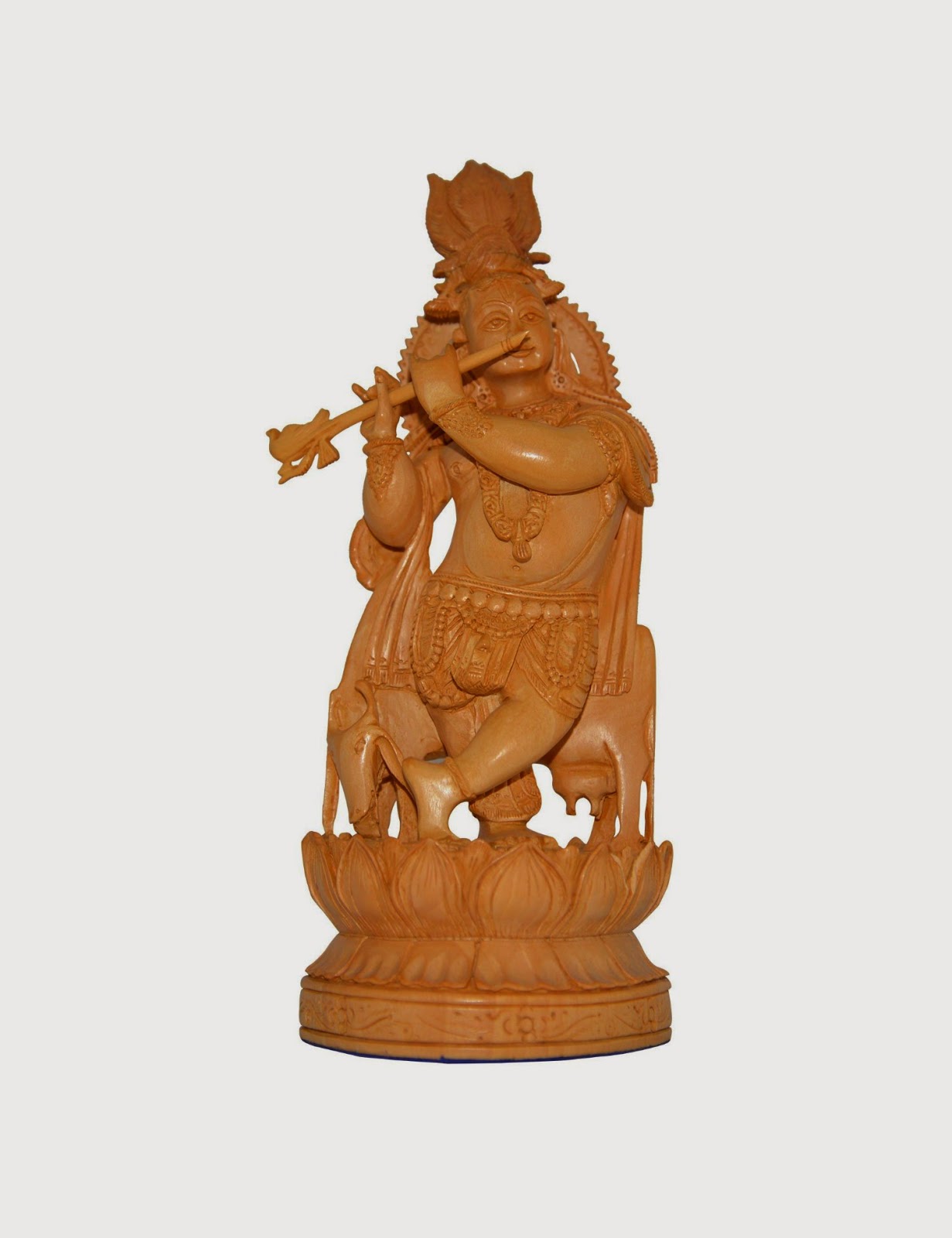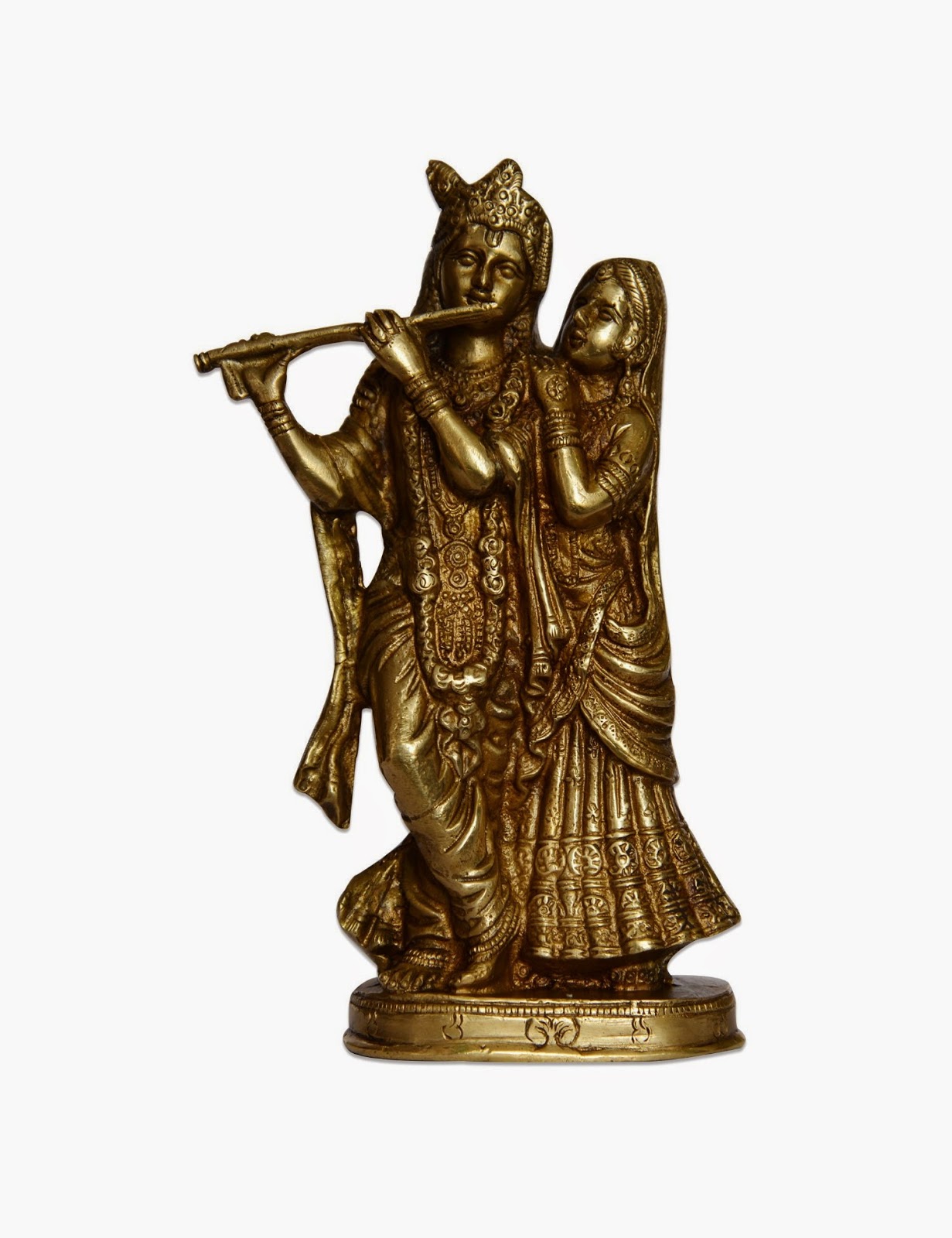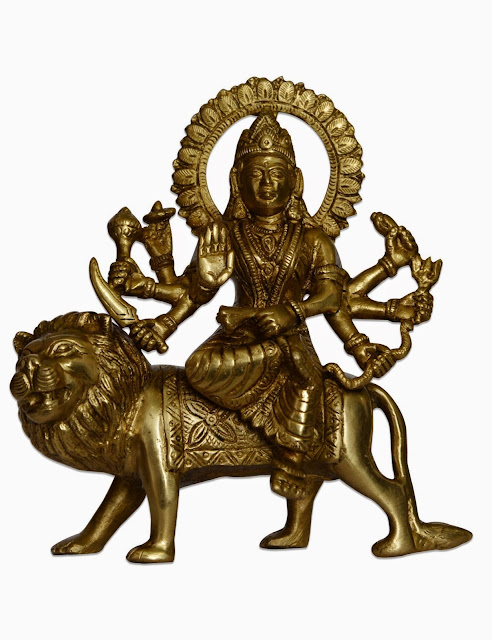Nanda was the head of a community of cow-herders, and he settled in Vrindavana. The stories of Lord Krishna's childhood and youth tell how he became a cow herder, his mischievous pranks as Makhan Chor (butter thief), his foiling of attempts to take his life, and his role as a protector of the people of Vrindavana.
Shri Krishna killed many Rakshasha's sent by Kansa (king of Mathura).
Krishna lifted the Govardhana hill to protect villagers of village vrindavan from the anger of Indra.
Shri Krishna’s childhood reinforces the Hindu concept of lila, playing for fun and enjoyment and not for sport or gain. His interaction with the gopis at the rasa dance or Rasa-lila . Krishna played his flute and the gopis came immediately from whatever they were doing, to the banks of the Yamuna River, and joined him in singing and dancing. Even those who could not physically be there joined him through meditation.
Saturday, 19 April 2014
Birth History Of Shree Krishna
Lord Krishna
was born to Devaki and her husband, Vasudeva Because of his sympathy for
the earth, the divine God Vishnu himself descended into the womb of Devaki and
was born as her son kanha (krishna),By the time of conception and birth of
Krishna, Devaki was married to Vasudeva and had already borne 7 children. The
Hindu Vishnu Purana relates: "Devaki bore in her womb the lotus-eyed
deity...before the birth of Shri Krishna, no one “could bear to gaze upon
Devaki, from the light that invested her, and those who contemplated her
radiance felt their minds disturbed.” This reference to light is reminiscent of
the Vedic hymn "To an Unknown God," which refers to a Golden Child.Krishna
belonged to the Vrishni clan of Yadavas from Mathura, and was the eighth son
born to the princess Devaki, and her husband Vasudeva.
Mathura
( district, Uttar Pradesh) was the capital of the Yadavas, to which Shri
Krishna's parents Vasudeva and Devaki belonged. King Kansa, Devaki's brother,
had ascended the throne by imprisoning his father, King Ugrasena. Afraid of a
prophecy from a divine voice from the heavens that predicted his death at the
hands of Devaki's eighth "garbha", Kamsa had the couple locked into a
prison cell. After Kansa killed the first six children, Devaki apparently had a
miscarriage of the seventh. However in reality, the womb was actually
transferred to Rohini secretly. This was how Balarama, Shri Krishna's elder
brother was born. Once again Devaki became pregnant. Now due to the
miscarriage, Kansa was in a puzzle regarding 'The Eighth One' but his ministers
advised that the divine voice from the heavens emphasised "the eight
garbha" and so this is the one. That night Krishna was born in the Rohini
nakshatra and simultaneously Goddess Durga was born as Yogamaya in Gokulam to
Nanda (Respectable person of Gokul village) and Yashoda (Nanda's wife). Since
Vasudeva knew Krishna's life was in danger, Krishna was secretly taken out of
the prison cell to be raised by his foster parents, Yasoda and Nanda, in Gokula
( Mathura district). Two of his other siblings also survived, Balarama
(Devaki's seventh child, transferred to the womb of Rohini, Vasudeva's first
wife) and Subhadra (daughter of Vasudeva and Rohini, born much later than
Balarama and Krishna).
Labels:
Achala,
Gopala,
Govinda,
Kanahiya,
Keshava,
Lord Krishna,
Madhusudhana.,
Manohar,
Murlidhar,
Nandlal
Location:
Gurgaon, Haryana, India
Names of Lord Krishna
Some Names of Lord Krishna :-
NAMES MEANING
Achala Still Lord
Anandsagar Compassionate Lord
Ananta The Endless Lord
Balgopal The Child Krishna, The All Attractive
Bali The Lord Of Strength
Chaturbhuj Four-Armed Lord
Devakinandan Son Of Mother Devaki
Dwarkapati Lord Of Dwarka
Gopal One Who Plays With The Cowherds, The Gopas
Govinda One Who Pleases The Cows
Hari The Lord Of Nature
Jagannath Lord Of The Universe
Kamalnayan The Lord With Lotus Shaped Eyes
Krishna Dark-Complexioned Lord
Lakshmikantam The Lord Of Goddess Lakshmi
Madan The Lord Of Love
Madhava Knowledge Filled God
Madhusudan Slayer Of Demon Madhu
Manmohan All Pleasing Lord
Murlidhar One Who Holds The Flute
Murlimanohar The Flute Playing God
Nandgopala The Son Of Nand
Narayana The Refuge Of Everyone
Paramatma Lord Of All Beings
Shyam Dark-Complexioned Lord
Shyamsundara Lord Of The Beautiful Evenings
Sudarshana Handsome Lord
Vaikunthanatha Lord Of Vaikuntha, The Heavenly Abode
Vishwatma Soul Of The Universe
NAMES MEANING
Achala Still Lord
Anandsagar Compassionate Lord
Ananta The Endless Lord
Balgopal The Child Krishna, The All Attractive
Bali The Lord Of Strength
Chaturbhuj Four-Armed Lord
Devakinandan Son Of Mother Devaki
Dwarkapati Lord Of Dwarka
Gopal One Who Plays With The Cowherds, The Gopas
Govinda One Who Pleases The Cows
Hari The Lord Of Nature
Jagannath Lord Of The Universe
Kamalnayan The Lord With Lotus Shaped Eyes
Krishna Dark-Complexioned Lord
Lakshmikantam The Lord Of Goddess Lakshmi
Madan The Lord Of Love
Madhava Knowledge Filled God
Madhusudan Slayer Of Demon Madhu
Manmohan All Pleasing Lord
Murlidhar One Who Holds The Flute
Murlimanohar The Flute Playing God
Nandgopala The Son Of Nand
Narayana The Refuge Of Everyone
Paramatma Lord Of All Beings
Shyam Dark-Complexioned Lord
Shyamsundara Lord Of The Beautiful Evenings
Sudarshana Handsome Lord
Vaikunthanatha Lord Of Vaikuntha, The Heavenly Abode
Vishwatma Soul Of The Universe
Labels:
Achala,
Gopala,
Govinda,
Kanahiya,
Keshava,
Lord Krishna,
Madhusudhana.,
Manohar,
Murlidhar,
Nandlal
Location:
Gurgaon, Haryana, India
Lord Krishna - Kanahiya- eighth incarnation of Lord Vishnu
Labels:
Achala,
Gopala,
Govinda,
Kanahiya,
Keshava,
Lord Krishna,
Madhusudhana.,
Manohar,
Murlidhar,
Nandlal
Location:
Gurgaon, Haryana, India
Friday, 18 April 2014
Maa Durga - The Adi-shakti of Vedas
Goddess Durga mean "the inaccessible or "the
invincible. Maa Durga is the most popular incarnation of Devi and one of the
main forms of the Goddess Shakti in the Hindu pantheon. Durga is the original
manifested form of Mother Adi-Parashakti. She is Adi- Parashakti herself. The
Devi Gita declares her to be the greatest Goddess. Thus, she is considered the
supreme Goddess and primary deity in Shaktism, occupying a place similar to
Lord Krishna in Vaishnavism. According to Skanda Purana, Goddess Parvati
accounted the name 'Durga' after she killed the demon Durgamaasura. Goddess
Parvati is considered to be the complete incarnation of Adi Parashakti or
Goddess Durga, with all other Goddesses being her incarnations or
manifestations. Whatever deity one is worshiping, ultimately, they are
worshiping her. Adi Parashakti or Mahadevi, the Supreme power, is called Durga
Shakti as per Devi-Mahatmya. Adi parashakti or Devi Durga is a Hindu concept of
the Ultimate Shakti or Mahashakti, the ultimate power inherent in all Creation.
According to Markandeya Purana she is Goddess Lakshmi and Goddess Saraswati in
her mild form; Goddess Kali and Goddess Chandi in her wrathful form.
Thursday, 17 April 2014
Handmade Rajasthani Damroo - Musical Instrument.
A damaru or damroo is a small two-headed drum, used in
Hinduism and Tibetan Buddhism. Damru is known as the instrument of Lord Shiva. Damru
was first created by Shiva to produce spiritual sounds by which this whole
universe has been created and regulated. The drum (damru) is typically made of
wood, with leather drum heads at both ends; the damaru might also be made
entirely out of human skulls. The resonator is made of brass. The height of the
damru is 6 inches and weight varies from 250-330 gm. Its height ranges from a
few inches to a little over one foot. It is played single headedly. The
strikers are typically beads fastened to the ends of leather cords around the
waist of the damaru. Knots in the leather can also be used as strikers, also
crochet material is common. As the player waves the drum using a twisting wrist
motion, the strikers beat on the drumhead. The damaru is very common throughout
the Indian subcontinent. The damaru is known as a power drum, and when played,
it is believed to generate spiritual energy. It is associated with the Hindu
deity Shiva. It is believed that Sanskrit language was recognized by the
drumbeats of the damaru (see Shiva Sutra for the sounds), and His performance
of the cosmic dance of tandava. The damaru is used by itinerant musicians of all
stripes, due to its small portable size. In the shield shape of some damaru’s,
the triangular upward representation also symbolizes male procreativity (the
Lingam), and the downward round representation symbolizes the female
procreativity (the Yoni). Symbolically, the creation of the world begins when
the lingam and yoni meet at the midpoint of the damaru, and the destruction
takes place when they separate from each other.
Labels:
Damaru,
Damroo,
Damru,
power drum.
Location:
Gurgaon, Haryana, India
Wednesday, 16 April 2014
Handmade Rajasthani Silk Table Runner
Table
runner is a long strip of cloth that is put down the middle of the table,
lengthways, to decorate it and to protect the surface from dishes, etc. We use
Table runner on a special occasion’s for decorations, a table runner is a simple
solution to cover a table and add colour or reflect a theme. There's no need
for a tablecloth when a runner is used; however, a formal table with a
tablecloth becomes more decorative with a runner. A white tablecloth topped
with a coloured runner is a simple choice. Runners also work well for
everyday use and will change a bare table into one with modest charm.
Themed table runners are available for holidays, birthdays or special events. A
simple red, white and blue runner is an option for a July Fourth celebration,
for instance.
Subscribe to:
Comments (Atom)







